Turbulent Flow Fields Over a 3D Hill Covered by Vegetation Canopy Through Large Eddy Simulations
Abstract
1. Introduction
2. Numerical Model
2.1. Governing Equations
2.2. Configurations
2.3. Mesh of the Model
2.4. Boundary Conditions
2.5. Solution Schemes
3. Numerical Results
3.1. Generated TBL
3.2. Instanteneous Flow Fields
3.3. LES Statistics
3.4. TKE Budget
3.5. Spectrum
4. Conclusions
- The production of turbulence from the canopy is the source of the secondary peak spanwise fluctuations in the hill wake. Moreover, two pairs of peak vertical velocity downstream of the hill crest were identified from the three-dimensional view of the mean velocities. One pair was located at the shear layer, and the other located in the central wake.
- The energies of the fluctuating velocities are condensed, represented by steeper caves on the spectrum distributions, suggesting the generation of the energetic coherent structures. Additionally, the similar spectra at P2 and P3 are the indications that the topography-generated coherent structures have significant effects on the velocities upstream.
- A pair of the lateral shedding are the reason for the double peaks on the distributions of σu, Sku, Kuu, and Ruu. The turbulence structures in the hill consist of the lateral shedding, the shedding from the hill crest, as well as the canopy-induced rotations. The lateral shedding and the shedding from the hill crest yield an area with quite small velocities and weak vortices, leading to the formation of a dead flow area.
Author Contributions
Funding
Conflicts of Interest
References
- Politis, E.S.; Prospathopoulos, J.; Cabezon, D.; Hansen, K.S.; Chaviaropoulos, P.K.; Barthelmie, R.J. Modeling wake effects in large wind farms in complex terrain: The problem, the methods and the issues. Wind Energy 2011, 15, 161–182. [Google Scholar] [CrossRef]
- Carvalho, A.C.; Carvalho, A.; Gelpi, I.; Barreiro, M.; Borrego, C.; Miranda, A.I.; Pérez-Muñuzuri, V. Influence of topography and land use on pollutants dispersion in the Atlantic coast of Iberian Peninsula. Atmos. Environ. 2006, 40, 3969–3982. [Google Scholar] [CrossRef]
- Davenport, A.G.; King, J.P.C. The influence of topography on the dynamic wind loading of long span bridges. J. Wind Eng. Ind. Aerod. 1990, 36, 1373–1382. [Google Scholar] [CrossRef]
- Matusick, G.; Ruthrof, K.X.; Brouwers, N.C.; Hardy, G.S.J. Topography influences the distribution of autumn frost damage on trees in a Mediterranean-type Eucalyptus forest. Trees 2014, 28, 1449–1462. [Google Scholar] [CrossRef]
- Lopes, A.M.G.; Cruz, M.G.; Viegas, D.X. FireStation—An integrated software system for the numerical simulation of fire spread on complex topography. Environ. Modell. Softw. 2002, 17, 269–285. [Google Scholar] [CrossRef]
- Dupont, S.; Brunet, Y. Edge Flow and Canopy Structure: A Large-Eddy Simulation Study. Bound. Layer Meteorol. 2008, 126, 51–71. [Google Scholar] [CrossRef]
- Takahashi, T.; Ohtsu, T.; Yassin, M.F.; Kato, S.; Murakami, S. Turbulence characteristics of wind over a hill with a rough surface. J. Wind Eng. Ind. Aerod. 2002, 90, 1697–1706. [Google Scholar] [CrossRef]
- Cao, S.; Tamura, T. Experimental study on roughness effects on turbulent boundary layer flow over a two-dimensional steep hill. J. Wind Eng. Ind. Aerod. 2006, 94, 1–19. [Google Scholar] [CrossRef]
- Cao, S.; Tamura, T. Effects of roughness blocks on atmospheric boundary layer flow over a two-dimensional low hill with/without sudden roughness change. J. Wind Eng. Ind. Aerod. 2007, 95, 679–695. [Google Scholar] [CrossRef]
- Dupont, S.; Brunet, Y.; Finnigan, J.J. Large-eddy simulation of turbulent flow over a forested hill: Validation and coherent structure identification. Q. J. R. Meteorol. Soc. 2008, 134, 1911–1929. [Google Scholar] [CrossRef]
- Ishihara, T.; Fujino, Y.; Hibi, K. A wind tunnel study of separated flow over a two-dimensional ridge and a circular hill. J. Wind Eng. 2001, 89, 573–576. [Google Scholar]
- Ishihara, T.; Hibi, K. Numerical study of turbulent wake flow behind a three-dimensional steep hill. Wind Struct. 2002, 5, 317–328. [Google Scholar] [CrossRef]
- Tamura, T.; Cao, S.; Okuno, A. LES Study of Turbulent Boundary Layer Over a Smooth and a Rough 2D Hill Model. Flow Turbul. Combust. 2007, 79, 405–432. [Google Scholar] [CrossRef]
- Liu, Z.; Ishihara, T.; Tanaka, T.; He, X.H. LES study of turbulent flow fields over a smooth 3-D hill and a smooth 2-D ridge. J. Wind Eng. Ind. Aerod. 2016, 153, 1–12. [Google Scholar] [CrossRef]
- Ferziger, J.H.; Peric, M. Computational Method for Fluid Dynamics; Springer: Berlin, Germany, 2002. [Google Scholar]
- Iizuka, S.; Kondo, H. Large-eddy simulations of turbulent flow over complex terrain using modified static eddy viscosity models. Atmos. Environ. 2006, 40, 925–935. [Google Scholar] [CrossRef]
- Lee, S.H.; Sung, H.J. Direct numerical simulation of the turbulent boundary layer over a rod-roughened wall. J. Fluid Mech. 2007, 584, 125–146. [Google Scholar] [CrossRef][Green Version]
- Ishihara, T.; Qi, Y.H. Numerical study of turbulent flow fields over steep terrains by using a modified delayed detached eddy simulation. Bound. Layer Meteorol. 2018, 170, 1–24. [Google Scholar] [CrossRef]
- Liu, Z.; Cao, S.; Liu, H.; Ishihara, T. Large-eddy simulations of mean and turbulent flow and coherent structures over an isolated 3D hill. Bound. Layer Meteorol. 2018, 170, 1–27. [Google Scholar]
- Ghodke, D.C.; Apte, V.S. DNS study of particle-bed–turbulence interactions in an oscillatory wall-bounded flow. J. Fluid Mech. 2018, 792, 232–251. [Google Scholar] [CrossRef]
- Ghodke, D.C.; Apte, V.S. Roughness effects on the second-order turbulence statistics in oscillatory flows. Comput. Fluids. 2018, 162, 160–170. [Google Scholar] [CrossRef]
- Ghodke, D.C.; Apte, V.S. Spatio–temporal analysis of hydrodynamic forces on the particle bed in an oscillatory flow environment. J. Fluid Mech. 2018, 841, 167–202. [Google Scholar] [CrossRef]
- Childers, D. Modern Spectrum Analysis; Chapter II; IEEE Press: New York, NY, USA, 1978. [Google Scholar]
- Kay, S.; Marple, S. Spectrum Analysis: A Modern Perspective. Proc. IEEE 1981, 69, 1380–1419. [Google Scholar] [CrossRef]
- Press, W.; Teukolsky, S.; Vetterling, W.; Flanney, B. Numerical Recipes 3rd Edition: The Art of Scientific Computing; Cambridge University Press: Cambridge, UK, 2007; pp. 681–685. [Google Scholar]
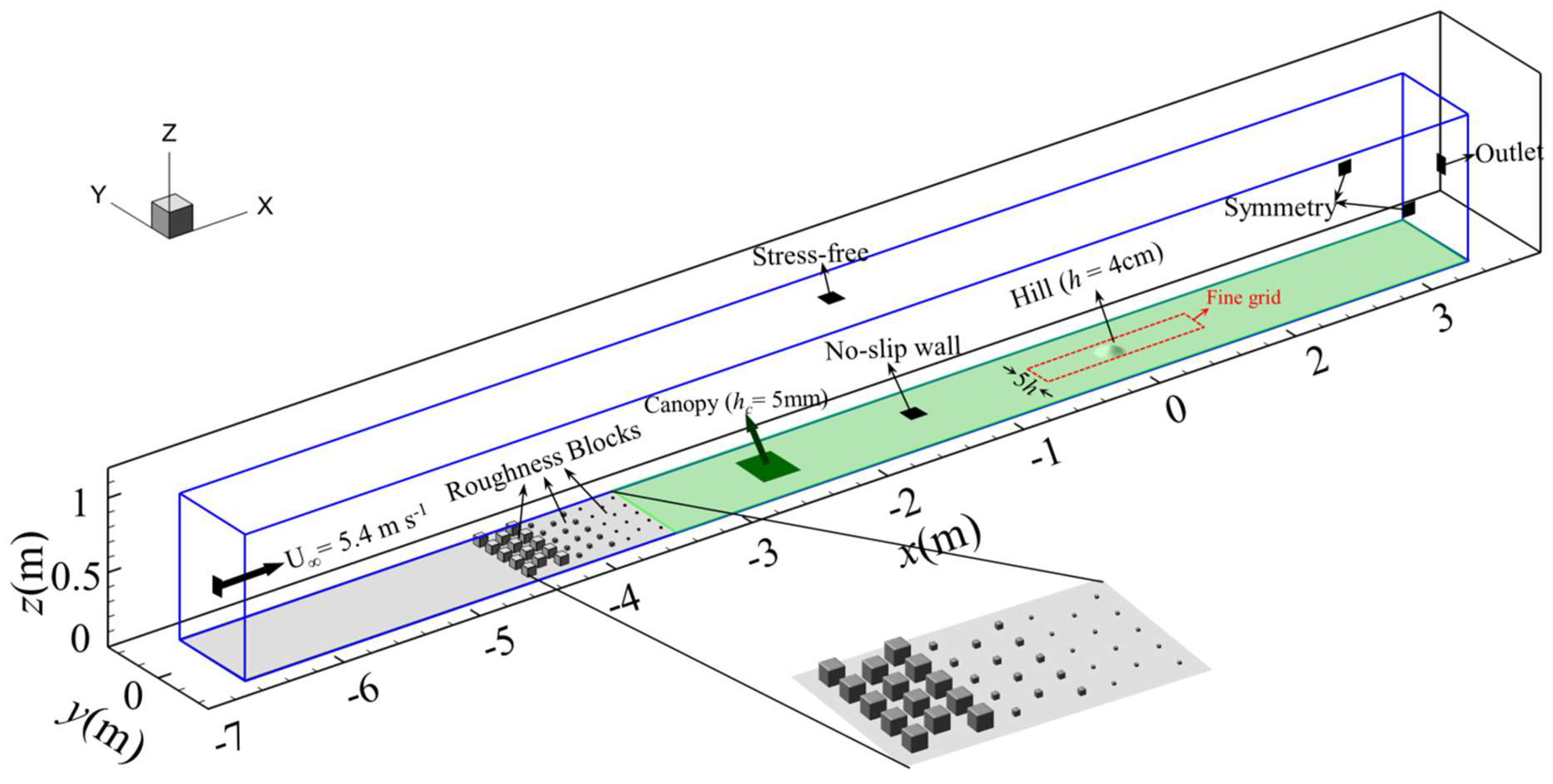
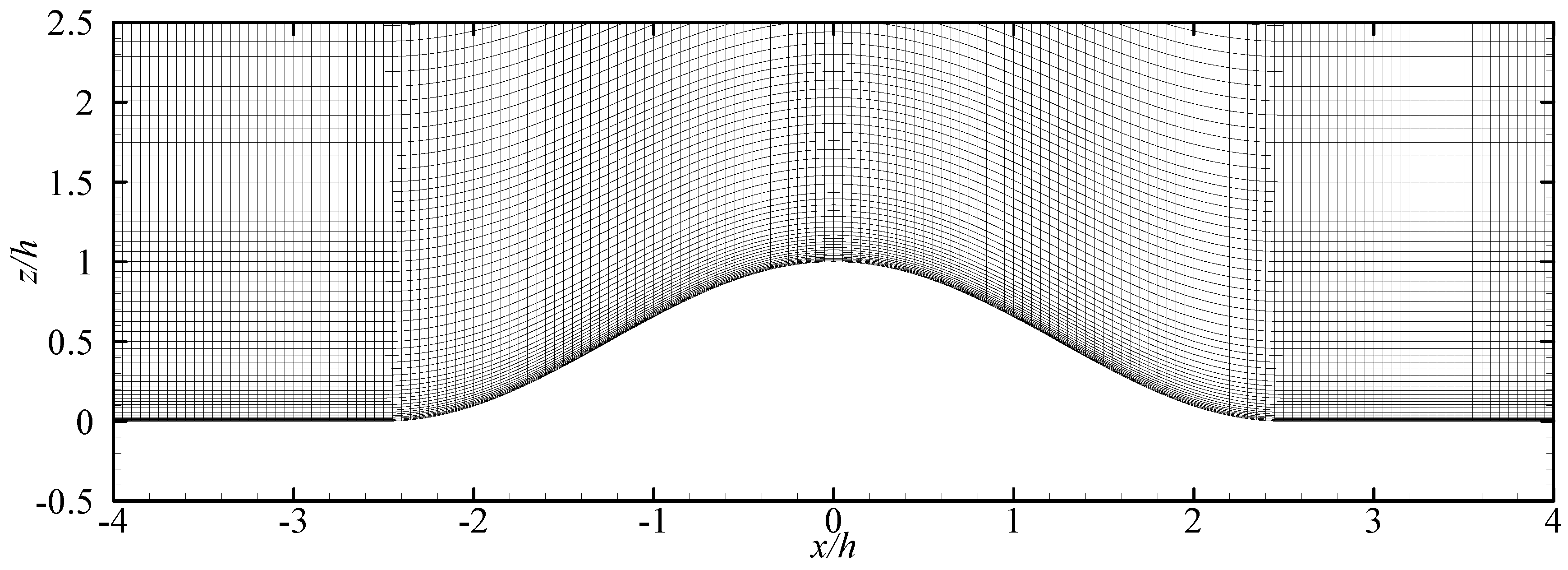
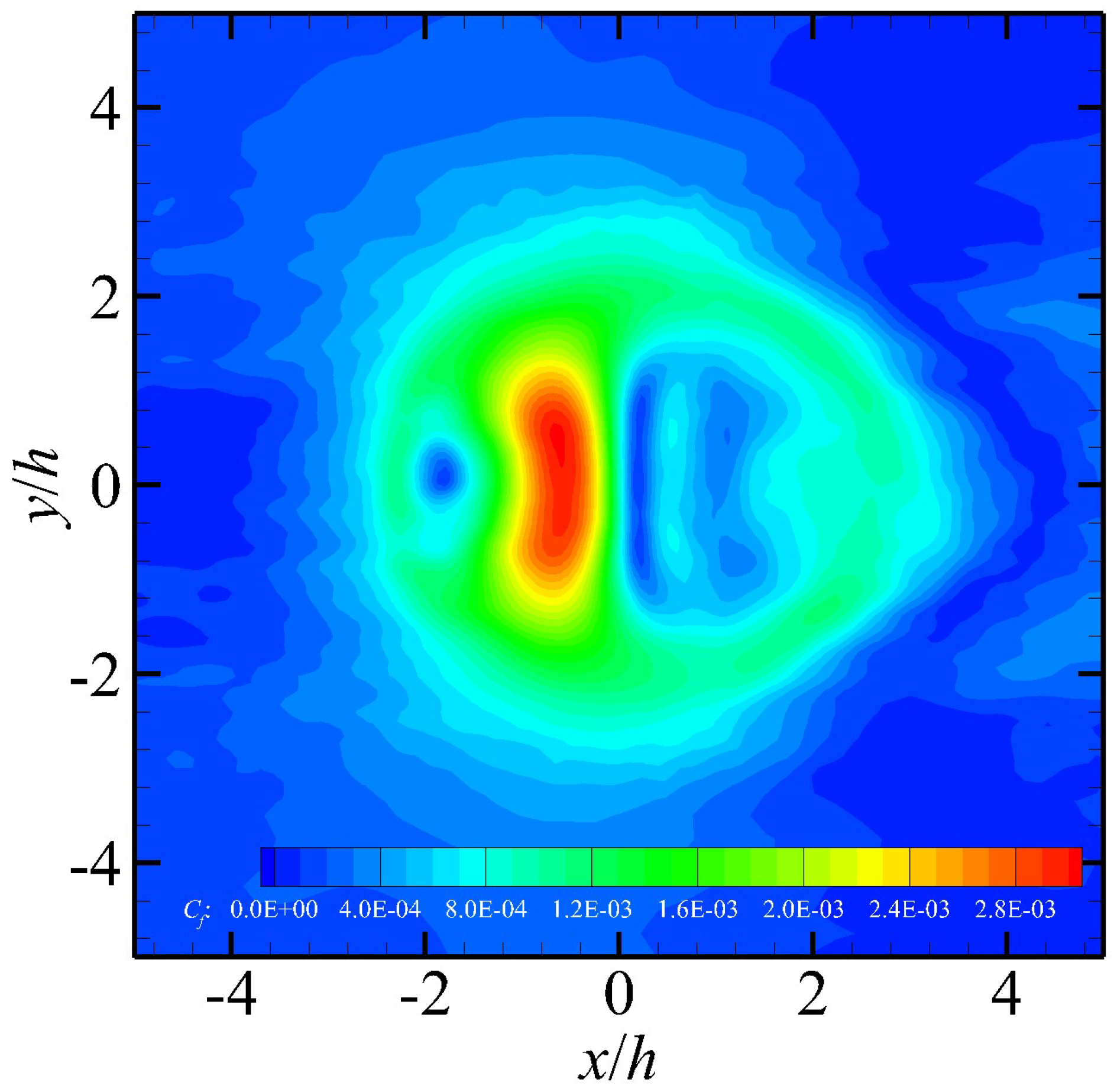
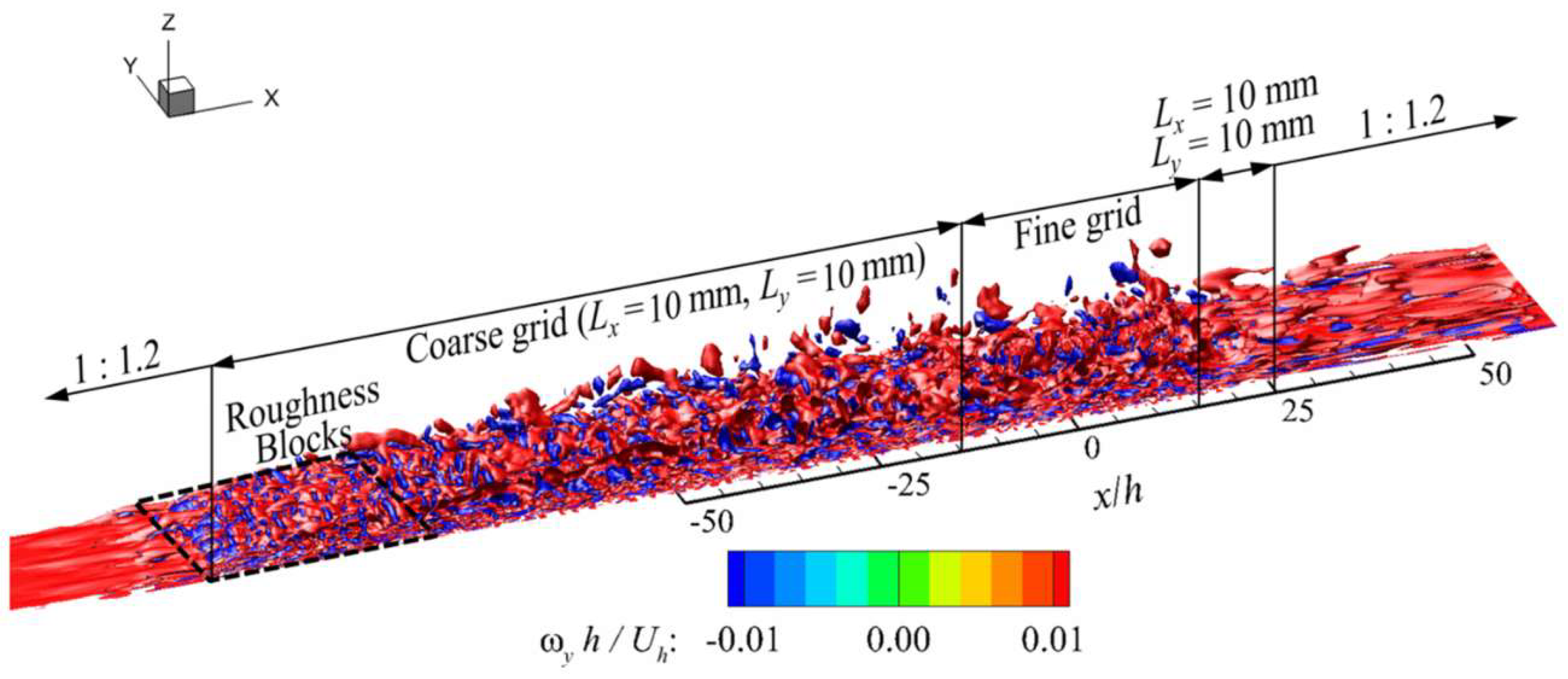
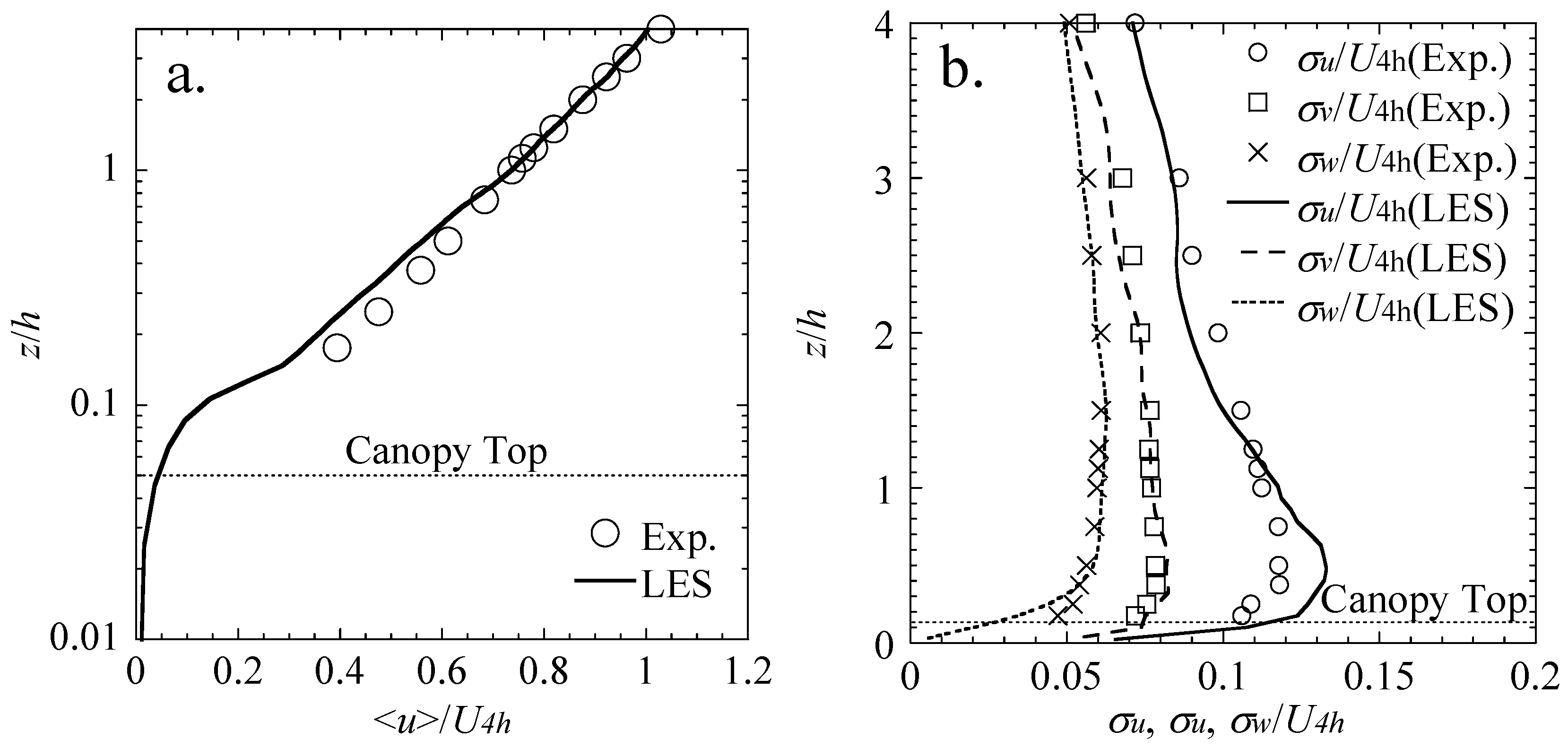
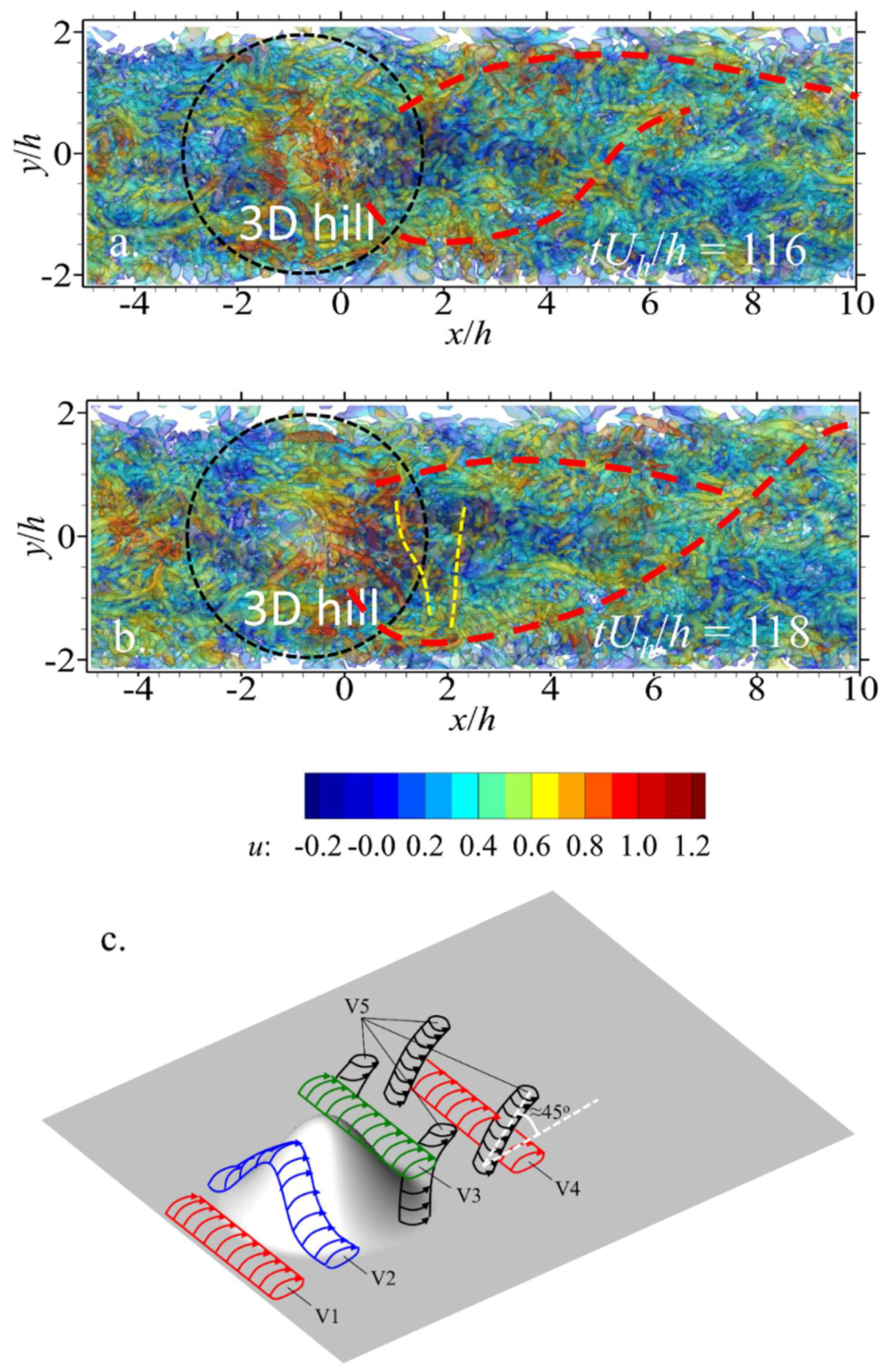
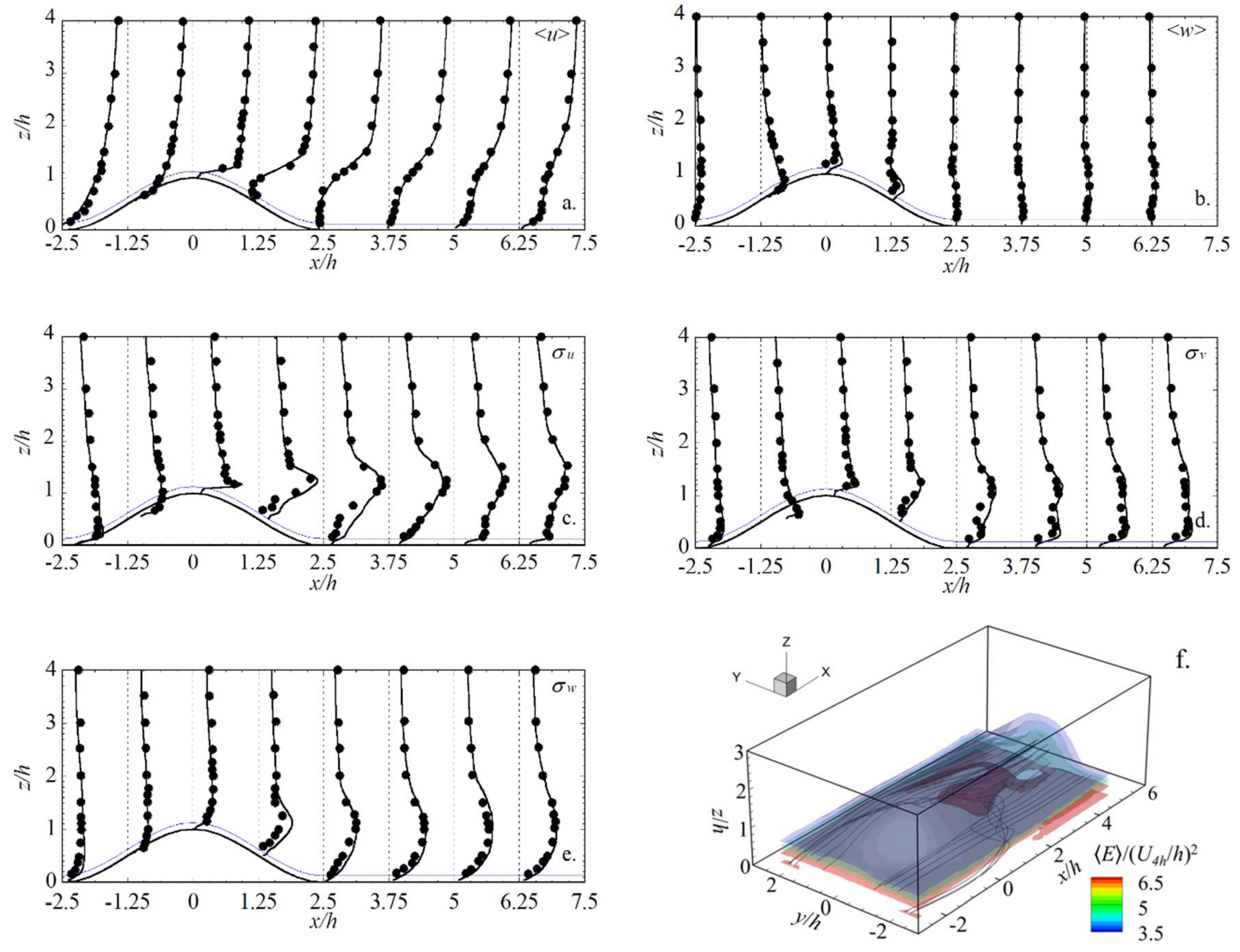
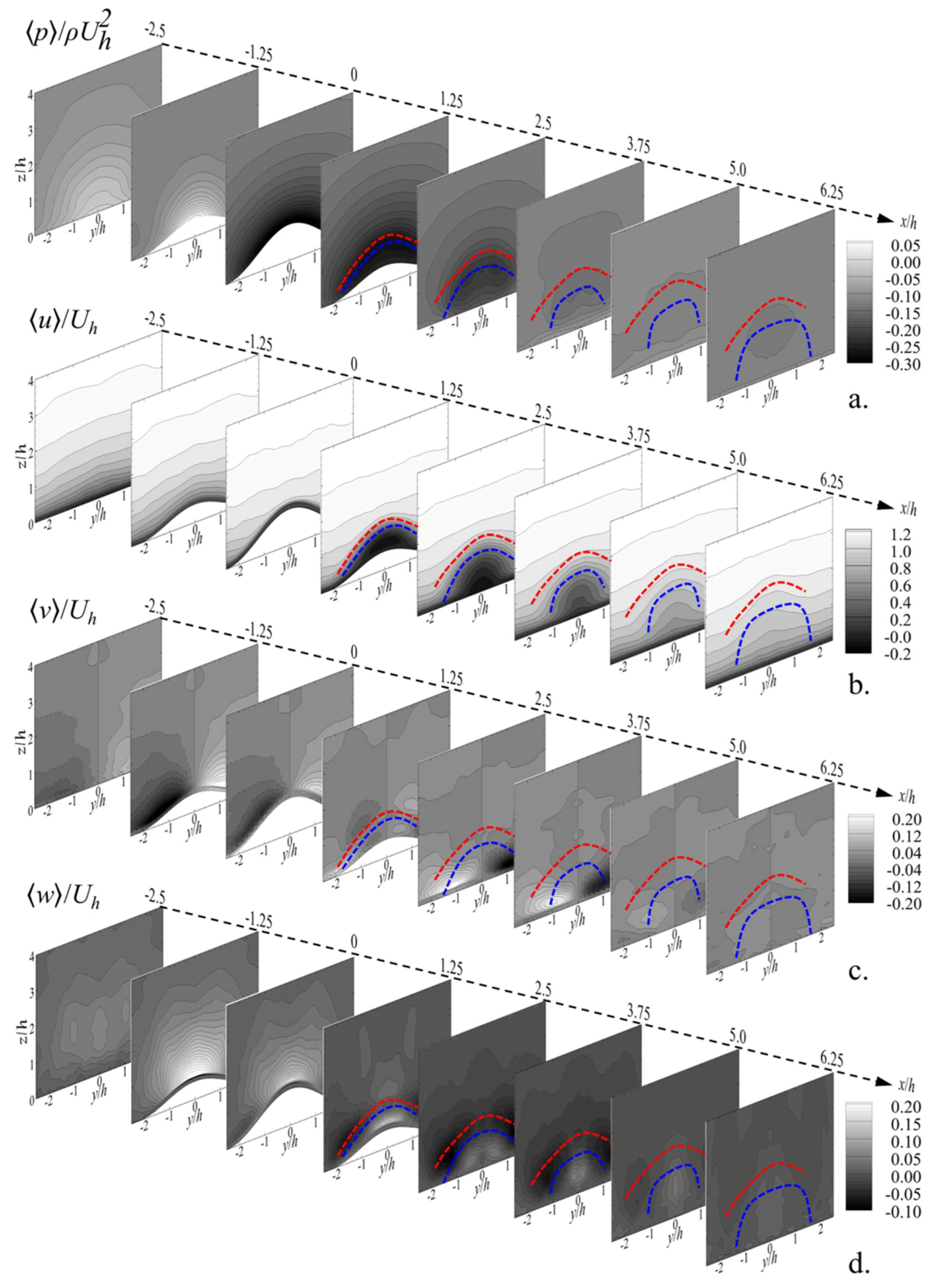
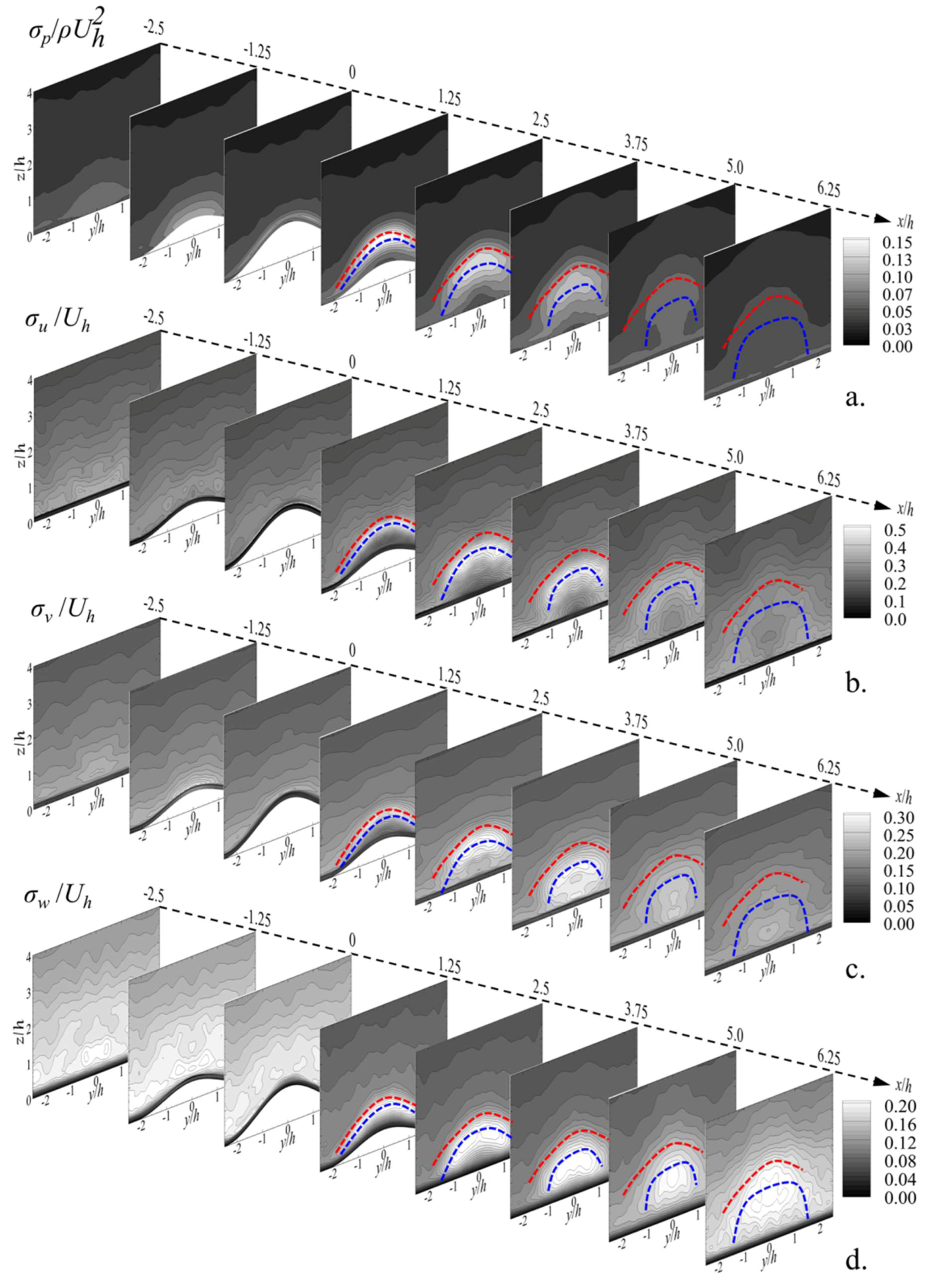
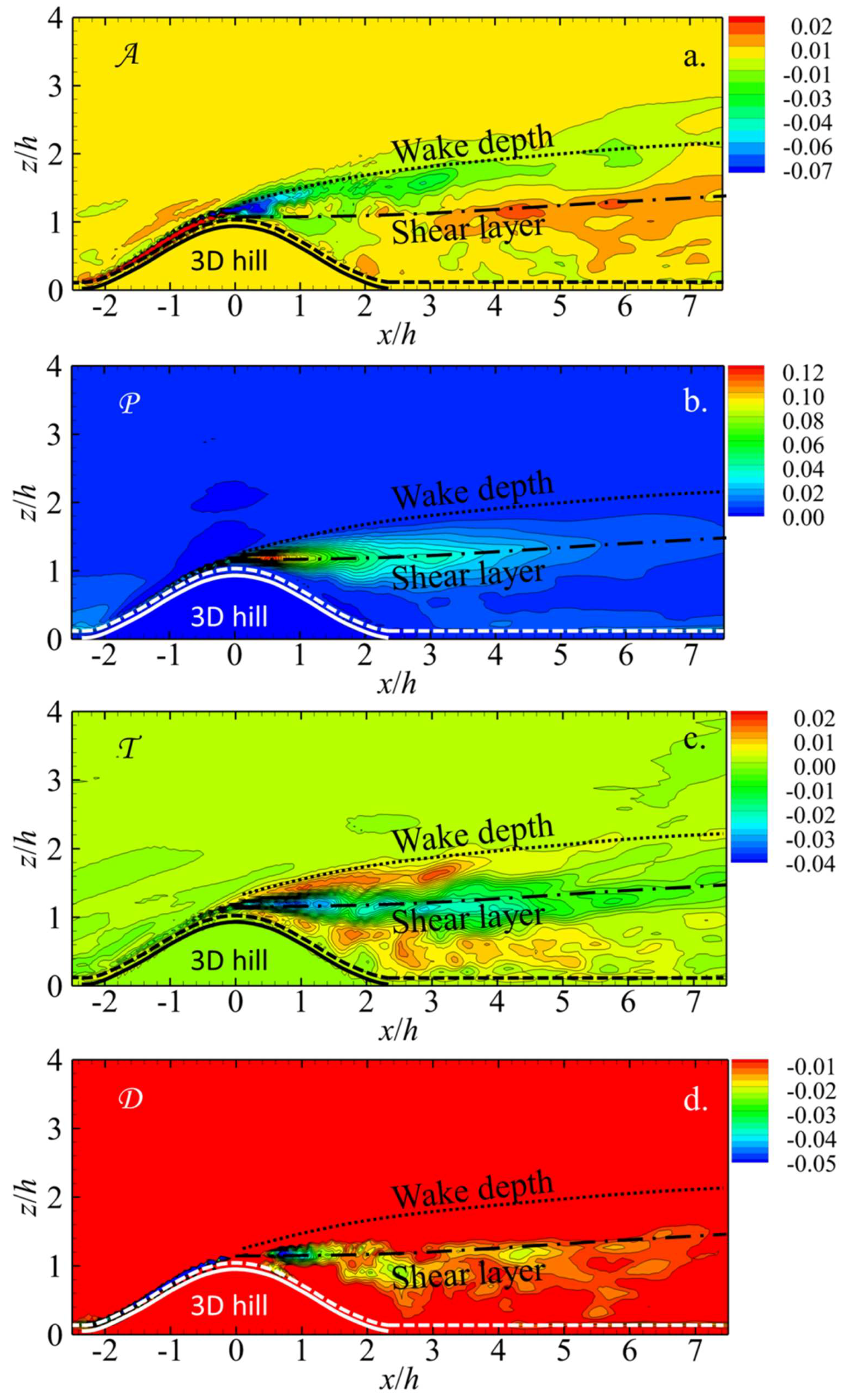
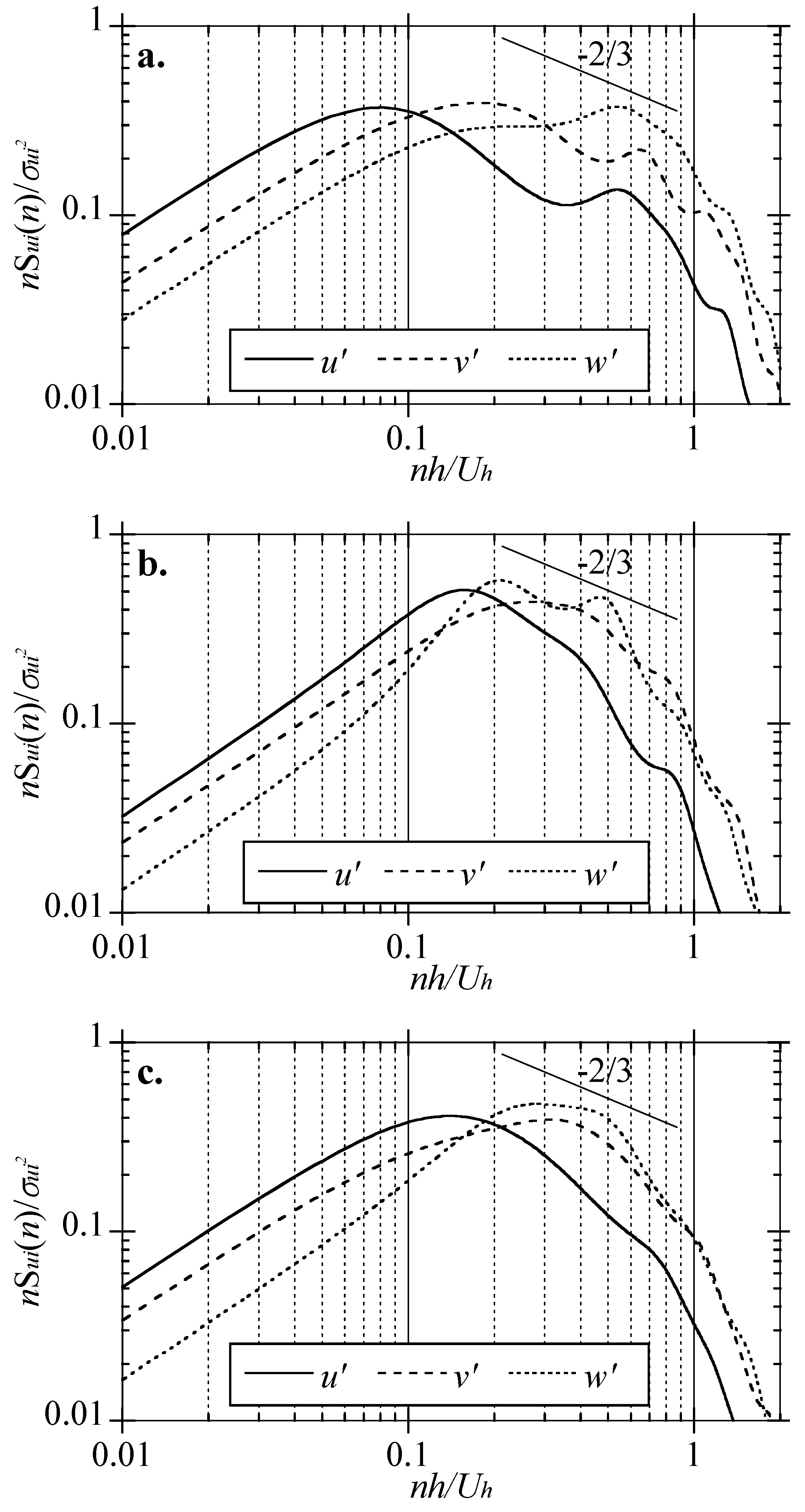
© 2019 by the authors. Licensee MDPI, Basel, Switzerland. This article is an open access article distributed under the terms and conditions of the Creative Commons Attribution (CC BY) license (http://creativecommons.org/licenses/by/4.0/).
Share and Cite
Liu, Z.; Hu, Y.; Fan, Y.; Wang, W.; Zhou, Q. Turbulent Flow Fields Over a 3D Hill Covered by Vegetation Canopy Through Large Eddy Simulations. Energies 2019, 12, 3624. https://doi.org/10.3390/en12193624
Liu Z, Hu Y, Fan Y, Wang W, Zhou Q. Turbulent Flow Fields Over a 3D Hill Covered by Vegetation Canopy Through Large Eddy Simulations. Energies. 2019; 12(19):3624. https://doi.org/10.3390/en12193624
Chicago/Turabian StyleLiu, Zhenqing, Yiran Hu, Yichen Fan, Wei Wang, and Qingsong Zhou. 2019. "Turbulent Flow Fields Over a 3D Hill Covered by Vegetation Canopy Through Large Eddy Simulations" Energies 12, no. 19: 3624. https://doi.org/10.3390/en12193624
APA StyleLiu, Z., Hu, Y., Fan, Y., Wang, W., & Zhou, Q. (2019). Turbulent Flow Fields Over a 3D Hill Covered by Vegetation Canopy Through Large Eddy Simulations. Energies, 12(19), 3624. https://doi.org/10.3390/en12193624





